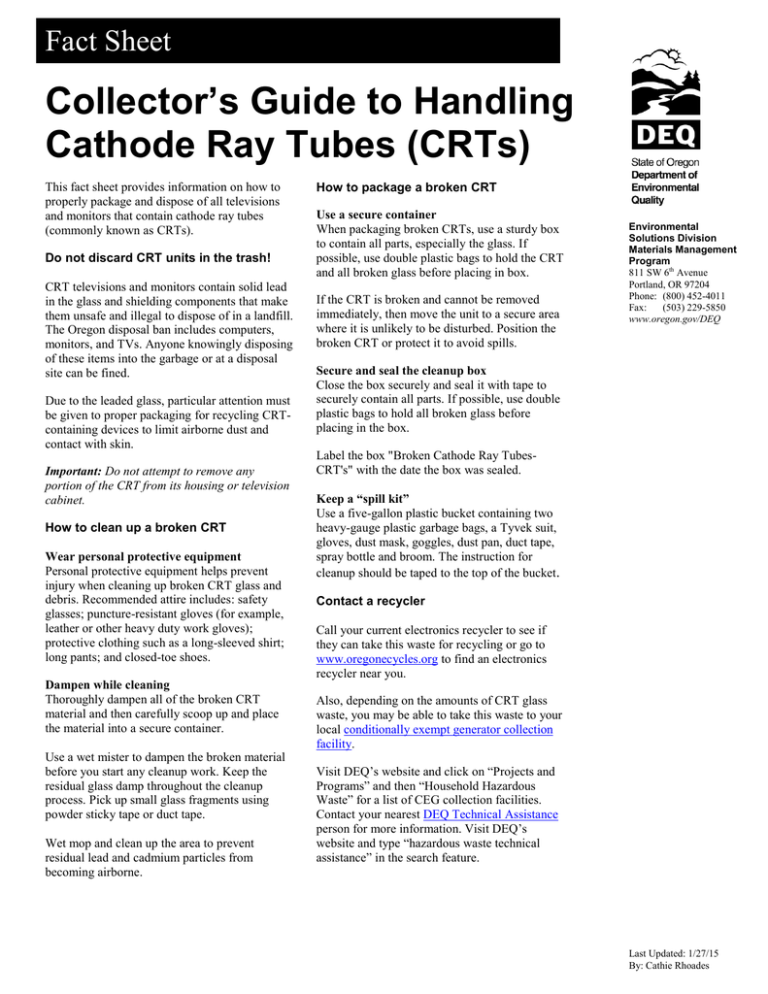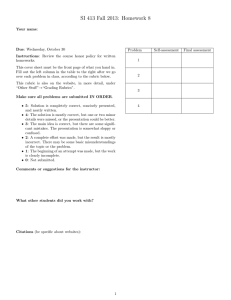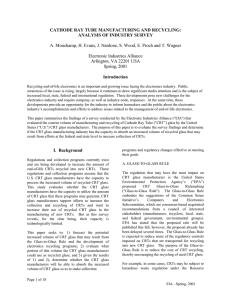Collector`s Guide to Handling Cathode Ray Tubes (CRTs)
advertisement

Fact Sheet Collector’s Guide to Handling Cathode Ray Tubes (CRTs) This fact sheet provides information on how to properly package and dispose of all televisions and monitors that contain cathode ray tubes (commonly known as CRTs). Do not discard CRT units in the trash! CRT televisions and monitors contain solid lead in the glass and shielding components that make them unsafe and illegal to dispose of in a landfill. The Oregon disposal ban includes computers, monitors, and TVs. Anyone knowingly disposing of these items into the garbage or at a disposal site can be fined. Due to the leaded glass, particular attention must be given to proper packaging for recycling CRTcontaining devices to limit airborne dust and contact with skin. Important: Do not attempt to remove any portion of the CRT from its housing or television cabinet. How to clean up a broken CRT Wear personal protective equipment Personal protective equipment helps prevent injury when cleaning up broken CRT glass and debris. Recommended attire includes: safety glasses; puncture-resistant gloves (for example, leather or other heavy duty work gloves); protective clothing such as a long-sleeved shirt; long pants; and closed-toe shoes. Dampen while cleaning Thoroughly dampen all of the broken CRT material and then carefully scoop up and place the material into a secure container. Use a wet mister to dampen the broken material before you start any cleanup work. Keep the residual glass damp throughout the cleanup process. Pick up small glass fragments using powder sticky tape or duct tape. Wet mop and clean up the area to prevent residual lead and cadmium particles from becoming airborne. How to package a broken CRT Use a secure container When packaging broken CRTs, use a sturdy box to contain all parts, especially the glass. If possible, use double plastic bags to hold the CRT and all broken glass before placing in box. If the CRT is broken and cannot be removed immediately, then move the unit to a secure area where it is unlikely to be disturbed. Position the broken CRT or protect it to avoid spills. Environmental Solutions Division Materials Management Program 811 SW 6th Avenue Portland, OR 97204 Phone: (800) 452-4011 Fax: (503) 229-5850 www.oregon.gov/DEQ Secure and seal the cleanup box Close the box securely and seal it with tape to securely contain all parts. If possible, use double plastic bags to hold all broken glass before placing in the box. Label the box "Broken Cathode Ray TubesCRT's" with the date the box was sealed. Keep a “spill kit” Use a five-gallon plastic bucket containing two heavy-gauge plastic garbage bags, a Tyvek suit, gloves, dust mask, goggles, dust pan, duct tape, spray bottle and broom. The instruction for cleanup should be taped to the top of the bucket. Contact a recycler Call your current electronics recycler to see if they can take this waste for recycling or go to www.oregonecycles.org to find an electronics recycler near you. Also, depending on the amounts of CRT glass waste, you may be able to take this waste to your local conditionally exempt generator collection facility. Visit DEQ’s website and click on “Projects and Programs” and then “Household Hazardous Waste” for a list of CEG collection facilities. Contact your nearest DEQ Technical Assistance person for more information. Visit DEQ’s website and type “hazardous waste technical assistance” in the search feature. Last Updated: 1/27/15 By: Cathie Rhoades





